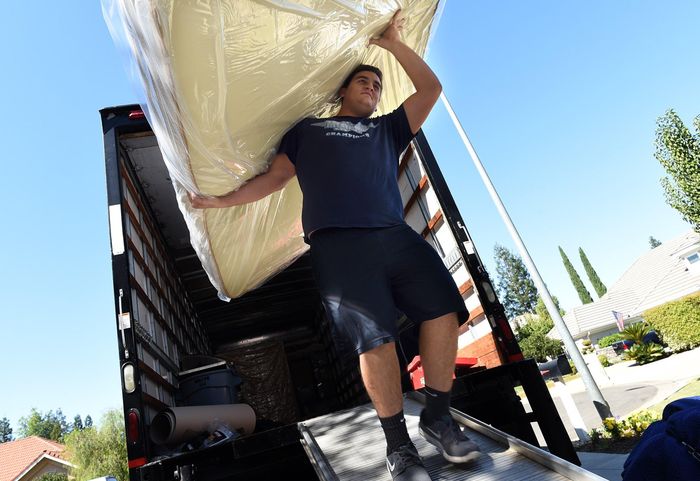Table of Contents

Key Takeaways
-
Identify the most affordable moving companies by comparing quotes and checking for hidden fees.
-
Save on moving costs by booking during off-peak seasons and being flexible with your move dates.
-
Understand the difference between full-service and self-service movers to choose the right option for your budget.
-
Pack smartly using affordable materials and efficient methods to protect your belongings and save money.
-
Stay informed about moving insurance options to ensure your items are covered without overspending.
Identifying Cost-Efficient Moving Companies
Let’s dive right in and tackle the first thing on your mind: finding a moving company that won’t break the bank. It’s all about striking a balance between cost and reliability. You don’t want to skimp on service quality, but you also don’t want to overpay. Here’s what you need to do:
-
Start by gathering quotes from several moving companies. Don’t just look at the bottom line; compare the services included.
-
Check the companies’ Better Business Bureau (BBB) ratings. A good rating can indicate a trustworthy company that delivers on its promises.
-
Read customer reviews and look for recurring themes. If a company consistently receives praise or complaints about a particular aspect, take note.
Remember, the cheapest option may not always be the best. Look for value—where the price meets your needs for safety, speed, and service.
Comparison of Service Versus Price
Understanding the types of services offered is crucial. Full-service movers handle everything from packing to unpacking, which is convenient but often pricier. Self-service movers, on the other hand, provide a more hands-on approach where you pack, and they drive. Here’s a quick comparison:
|
Service Type |
Pros |
Cons |
Cost |
|---|---|---|---|
|
Full-Service Movers |
Convenience, less physical work for you |
Higher cost |
$$$ |
|
Self-Service Movers |
Lower cost, more control over packing |
More work for you |
$$ |
Decide which services you really need. Can you pack your own boxes? Do you need help with heavy furniture? Tailor the service to your budget and effort you’re willing to put in. For more information, check out this list of the best cheap moving companies to fit your needs.
Booking Strategies for Lower Costs
Timing is everything when it comes to moving on a budget. Most people move during the summer months or at the beginning and end of a month. If you can, aim for a mid-month, mid-week move. Demand is lower, which can lead to lower prices.
Another tip is to book early. The earlier you lock in your date, the more likely you are to get a better rate. Movers often have more flexibility and willingness to negotiate when their schedule isn’t packed.
Lastly, don’t be afraid to negotiate. If you have quotes from multiple companies, use them as leverage to get a better deal. It never hurts to ask!

Making Your Move Stress-Free with Affordable Movers
Now, let’s shift gears and focus on making your move as stress-free as possible. It’s not just about finding the cheapest service; it’s about ensuring that service meets your needs and eases the burden of moving day.
A Step-by-Step Guide to Choosing Your Moving Service
First, list out what services you need. Then, reach out for quotes. Once you have a few, compare them side by side. Look for:
-
Line items that match the services you need
-
Any additional fees that could pop up
-
The total cost, not just the headline figure
Once you’ve found a few good candidates, call them. Yes, actually pick up the phone and talk to them. You can learn a lot about a company’s customer service by how they handle your questions.
Understanding the Different Types of Moves and Their Costs
Local moves are generally charged by the hour, while long-distance moves are based on the weight of your items and the distance traveled. Here’s a basic breakdown:
-
Local moves: Look for an hourly rate plus a possible truck fee.
-
Long-distance moves: Expect a weight-based rate plus any additional services.
Because moving costs can vary so much, it’s hard to say exactly what you’ll pay. But for a local move, it’s common to see rates between $80-$100 per hour for a team of two movers. Long-distance moves can start around $2,000 and go up from there based on the total weight and miles.
Hidden Fees in Low-Cost Moving Services and How to Avoid Them
Beware of hidden fees that can sneak into your moving costs. Things like ‘stair fees’ or ‘long carry fees’ can add up if you’re not careful. Here’s how to keep those sneaky extra charges at bay:
Always ask for a comprehensive list of all potential fees before you book. If something sounds unclear, ask for clarification. You have the right to understand exactly what you’re paying for.
And there you have it—your first steps toward finding an affordable moving company that fits your needs and budget. For more in-depth advice on affordable mover hiring strategies, stay tuned for tips on packing, insurance, and getting settled into your new place without emptying your wallet.
Planning a Move: Creating a Budget-Friendly Checklist
Creating a budget-friendly checklist is your roadmap to a cost-effective move. Start by categorizing your expenses into ‘must-haves’ and ‘nice-to-haves’. Must-haves include things like moving truck rental, gas for the distance, and basic packing supplies. Nice-to-haves might be professional packing services or additional insurance. Here’s a simple checklist to get you started:
-
Truck rental or moving service fees
-
Packing materials: boxes, tape, bubble wrap
-
Travel costs: gas, food, lodging if it’s a long-distance move
-
Storage fees if needed
-
Cleaning supplies for your new and old place
By breaking down your expenses, you can see where to cut costs and where it’s worth spending a little extra.
Negotiating with Movers: Tips to Get the Best Deal
When it comes to negotiating with movers, it’s all about preparation and timing. Arm yourself with quotes from different companies and use them as bargaining chips. Be upfront about your budget constraints; many movers are willing to work with you to secure your business. Here are a few tips:
-
Be flexible with your moving dates to get lower rates.
-
Ask about discounts for cash payments, repeat customers, or referrals.
-
See if there are any promotions or off-season rates available.
Remember, it’s not just about getting the lowest price; it’s about getting the best value for your money.

Packing Like a Pro: Money-Saving Tips
When you’re looking to save money on your move, packing like a pro is where you can really make an impact. Efficient packing saves space, which means fewer trips or a smaller truck. Let’s get into how to pack efficiently and affordably.
Packing Materials: What You Need and Where to Find Them for Less
You’ll need boxes, tape, and packing material. But before you buy them new, see what you can get for free. Check local stores for boxes—they often have plenty they’re willing to give away. For packing material, use what you have: towels, blankets, and clothing can protect your items without costing extra. If you do need to buy supplies, compare prices at different stores or buy in bulk to save.
DIY Packing Strategies that Protect Your Belongings and Your Wallet
When you pack yourself, you’re in control. Start early and pack a little each day to avoid a last-minute rush. Label boxes clearly with their contents and the room they belong in. This not only helps you but also any movers you hire. Use sturdy boxes for heavy items and don’t overpack. An overstuffed box can break, and that could end up costing you more in damaged items.
Another tip is to pack a personal essentials box. Include things you’ll need right away in your new home, like toiletries, a few dishes, and a change of clothes. This saves you from having to unpack everything at once or make unnecessary purchases.
Understanding Moving Insurance Options
Insurance might not be the first thing on your mind when you’re trying to save money on a move, but it’s important. Without proper coverage, you could end up paying far more in the event of damage or loss. Let’s look at what options are available.
-
Basic carrier liability: This is often included by default, but the coverage is minimal.
-
Full-value protection: This is more comprehensive and covers the replacement value of lost or damaged items.
-
Third-party insurance: If you want extra coverage, consider a policy from an outside provider.
Standard Versus Full-Value Protection: What’s Right for You?
Standard liability might be included in your moving cost, but it usually covers only a fraction of your items’ value—often 60 cents per pound per item. Full-value protection, while more expensive, could be worth the investment for valuable items. Consider the total value of your belongings and what you can afford to lose or replace out-of-pocket.
Deciphering Moving Insurance Policies: Fine Print That Could Cost You
When it comes to moving insurance, the fine print matters. Look for clauses about deductible amounts, the claims process, and time limits for reporting issues. If anything is unclear, ask your moving company or insurance provider for clarification. Don’t wait until it’s too late to find out your coverage isn’t what you expected.
Finalizing Your Move: What to Expect on Moving Day
On moving day, expect a flurry of activity. To make things go smoothly, be prepared. Have everything packed and labeled. Keep important documents and valuables with you. Make sure there’s a clear path for movers to work. And most importantly, stay available to answer questions and give directions.
If you’ve hired movers, they’ll likely have a process they follow. Let them do their job, but don’t hesitate to speak up if you see something that concerns you. After all, it’s your move and your peace of mind on the line.
Remember, even the best-laid plans can face hiccups. Stay calm, be flexible, and keep your eye on the prize: settling into your new home without having spent a fortune to get there.
Last-Minute Challenges and How to Tackle Them
Even with meticulous planning, last-minute challenges can arise. Maybe the weather turns on you, or a helper cancels at the eleventh hour. Here’s how to handle these surprises:
-
Have a backup plan for bad weather—rent tarps or plastic sheeting to protect your items.
-
If someone bails, have a list of backup helpers you can call, or know the local services you can reach out to for last-minute labor.
-
Keep an emergency kit handy with essentials like tools, tape, and cash for any unexpected needs.
Stay positive and focused. A solution-oriented mindset will see you through the unexpected.

Frequently Asked Questions (FAQ)
Finding the cheapest moving company doesn’t have to be a guessing game. Here are answers to some of the most common questions to help you navigate your budget-friendly move.
How can I verify if a moving company is licensed and insured?
Verifying a moving company’s credentials is straightforward. Ask the company for their Department of Transportation (DOT) license number, and use it to check their status on the Federal Motor Carrier Safety Administration (FMCSA) website. This site will also show you their insurance status and any complaints filed against them.
What is the average cost of hiring affordable movers for a local vs. long-distance move?
The average cost for hiring movers for a local move typically ranges between $300 to $1,500, depending on the size of the move and the services you need. For long-distance moves, costs can start from $2,000 to $5,000 and up. Always get multiple quotes to find the most affordable option for your specific situation.
Is it cheaper to move during a particular time of the year?
Yes, moving costs can vary throughout the year. Winter months are often less expensive due to lower demand. Additionally, moving on a weekday in the middle of the month can also save you money compared to weekend moves at the beginning or end of the month.
Can I negotiate the price with moving companies?
Absolutely. Movers are often open to negotiation, especially if you have lower quotes from their competitors. Don’t hesitate to discuss your budget and ask if there’s any room for adjustment in their pricing. For more insights on how to save money, check out this budget moving guide.
What should I do if my belongings are damaged during the move?
If you discover damage after your move, document it with photos and contact the moving company immediately to file a claim. Be sure to review your contract and insurance policy beforehand so you’re aware of the procedure and any deadlines for filing claims.



